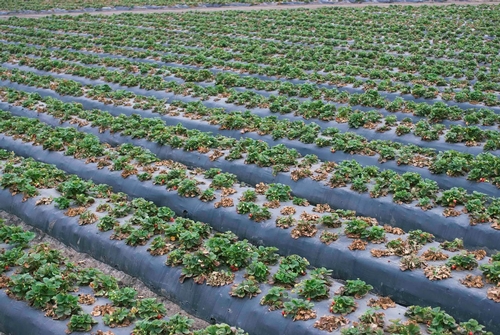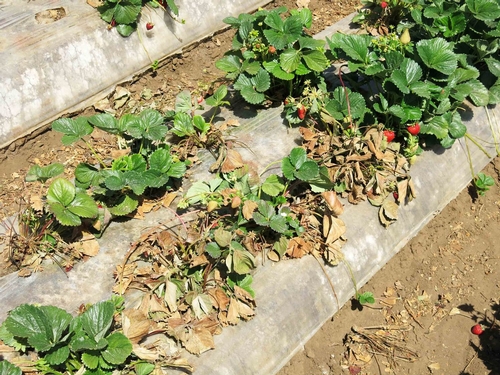
- Author: Mark Bolda
- Author: Steven Koike
Accompanying the current spate of Macrophomina and Fusarium discoveries by the UCCE Diagnostic Laboratory in Salinas and by other pathologists, growers, farm managers, and PCAs are now faced with the question of what the next step should be.
Fumigation: The advice for growers and farm managers is to avoid bed fumigation at this juncture. Even beds fumigated by professional operators will have little reservoirs of surviving pathogens on the shoulders where the fumigant did not travel. Of great concern are pathogen populations surviving in the soil making up the untreated furrows. Growers who are not flat fumigating with methyl bromide + chloropicrin should consider using a high rate of chloropicrin under impermeable film. This likely will not be as good a treatment as the mix of methyl bromide + chloropicrin used in the past, but it is the next best soil treatment solution.
Reducing stress to the plants: The diseases caused by both Macrophomina and Fusarium develop earlier, more rapidly, and more severely if plants are stressed. Strawberries that are under-chilled or subject to irrigation deficits, fertility shortfalls, and/or pest issues (such as mites) can succumb fairly rapidly, while those perfectly managed can withstand disease for a longer time. Growers wanting to reduce their diseases losses from here on out will need to play a tight defensive game and address plant stress factors in a timely manner.
Not disturbing the existing bed: The in-field spread of both Macrophomina and Fusarium is mainly accomplished by tillage and other procedures that move soil around. Because neither pathogen makes airborne spores (such as those made by powdery mildew and gray mold pathogens) or swimming zoospores found in soil water (produced by Phytophthora), the spread of inoculum is only by physical movement of the soil. Presumably, beds remaining intact and in place, as they would be for second year strawberries or other system of minimal tillage, will keep the pathogen from being spread to non-infested parts of the field.
This situation has been observed locally. In 2013, a strawberry field had significant Macrophomina outbreaks in certain parts of the field. Held over for a second year, the dead areas were replanted and again developed disease in those sections; however, second year plants that were healthy in 2013 were mostly healthy in 2014. While growing second year strawberries is not being recommended, this type of situation demonstrates the key role of soil movement in disease epidemiology.
Sanitation: Sanitation is critical for limiting the spread of Macrophomina and Fusarium. Tractors, tillage equipment, and irrigation pipes moving from infested fields should be cleaned. Remember too that a strawberry field that had significant dieback two years ago and is now planted to lettuce or another crop, likely still has plenty of Fusarium or Macrophomina around. It is a good practice for all of us to pay attention to where we have been and clean up if you are coming out of an infested field.
Having the Right Attitude and Accept the Changing Reality: In this environment of new diseases and reduced to no availability of good fumigants, those able to keep open minds and adopt new practices stand the best chance to weather the storm from these new pathogens. Growers and agricultural professionals of all stripes MUST adapt to this new era. Go to meetings, keep up to date on the latest research, talk with reputable professionals and be ready to make the changes necessary to keep your crop the most productive it can possibly be.



- Author: Mark Bolda
I'm asking you as my readers to participate in a survey concerning soilborne pathogens in strawberries and caneberries. There's a few questions about what your expectations are in managing these, as well as a number of questions concerning how and where you normally obtain information on these matters.
I've taken it already, and find it to be a well thought out survey which takes about 5 minutes to do. I'd really appreciate your participation if not only for the two reasons given below.
A few years someone was trumpeting a survey he was party to that determined that UC Cooperative Extension wasn't even in the top five sources of information for growers. That always struck me as pretty strange, because my colleagues and I spend a good part of every day answering agriculture questions, and our meetings usually have a lot of people attend. Our websites don't lack for traffic (I think the UC IPM website alone gets like one million views a month) and we do a brisk business out of our offices distributing pamphlets and selling publications. Something doesn't match up with what that survey from a few years ago said, and so hopefully the survey here will help clarify what is going on and give us an idea of where we can improve our services.
Second, because I'm welcomed on to most ranches (not all though), I think I have a pretty good feel for what is going on with berries on the Central Coast. Quite frankly from what I have seen with my colleagues (especially Steven Koike from the Monterey CE office) over the past two years on the advance of soil pathogens is concerning, and we aren't even completely post methyl bromide yet. And that's the other big part of the survey which explores what you think matters most in soilborne pest management and what you think the scientific community should be doing about it.
But if you don't do the survey, we aren't going to know very much more about either of these.
Here's the link:
http://ucanr.edu/sites/Strawberry_soil-borne_diseases/


